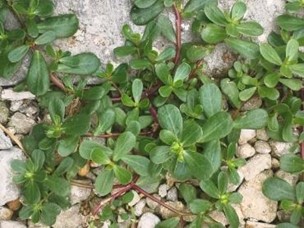Abstract
Purslane is often labeled as a noxious weed in Florida; however, this seemingly pesky plant is perceived as a nutritional powerhouse in Asia and other continents. Levels of vitamin A and E in purslane far surpass those found in broccoli, tomato, and lettuce. A mere 3.5 ounces of purslane can fulfill 81% of an individual's daily vitamin requirements, and up to half a pound can meet the daily needs for both Vitamins A and E. Sustaining this nutritional wealth hinges on the timing of harvest when purslane plants attain a height of 5 to 6 inches. Beyond this stage, purslane becomes excessively fibrous and aged, making it unsuitable for consumption and necessitating removal through weeding. This publication article provides a comprehensive overview of purslane, delving into its botany, garden production, harvest practices, and both culinary and medicinal uses to assist growers and consumers in understanding when to savor its nutritional benefits and when to weed it from farmlands.
References
Alam, M. A., A.S. Juraimi, M. Y. Rafii, A.A. Hamid, F. Aslani. 2014. “Screening of Purslane (Portulaca oleracea L.) Accessions for High Salt Tolerance.” The Scientific World Journal: 1–12. https://doi.org/10.1155/2014/627916
Angiosperm Phylogeny Group (APG). 2009. “An Update of the Angiosperm Phylogeny Group Classification for the Orders and Families of Flowering Plants: APG III.” Botanical Journal of the Linnean Society 161 (2): 105–121. https://doi.org/10.1111/j.1095-8339.2009.00996.x
Boulos, L. 1984. “The Genus Portulaca in Egypt.” Willdenowia 14 (1): 41–46.
Chugh, V., V. Mishra, S. V. Dwivedi, and K. D. Sharma. 2019. “Purslane (Portulaca oleracea L.): An Underutilized Wonder Plant with Potential Pharmacological Value.” The Pharma Innovation Journal 8 (6): 236–246. https://www.thepharmajournal.com/archives/2019/vol8issue6/PartE/8-5-92-356.pdf
Cui, L., G. Du, D. Zhang, H. Liu, and J. Chen. 2007. “Purification and Characterization of Transglutaminase from a Newly Isolated Streptomyces hygroscopicus.” Food Chemistry 105 (2): 612–618. https://doi.org/10.1016/j.foodchem.2007.04.020
Dehghan, F., R. Soori, K. Gholami, M. Abolmaesoomi, A. Yusof, S. Muniandy, S. Heidarzadeh, P. Farzanegi, and M. A. Aazarbayjani. 2016. “Purslane (Portulaca oleracea) seed consumption and aerobic training improves biomarkers associated with atherosclerosis in women with type 2 diabetes (T2D).” Scientific Reports 6: 37819. https://doi.org/10.1038/srep37819
Ghamari, H., J. S. Kolvanagh, S. H. Sabaghpour, and A. D. M. Nassab. 2016. “Effects of Chemical and Biological Fertilizers on Some Morpho-Physiological Traits of Purslane (Portulaca oleracea L.) and Dragon’s Head (Lallemantia iberica Fisch. & CA Mey) Cultivated under Intercropping System.” Notulae Scientia Biologicae 8 (1): 112–117. https://doi.org/10.15835/nsb819755
Graifenberg, A., L. Botrini, L. Giustiniani, F. Filippi, and M. Curadi. 2003. “Tomato Growing in Saline Conditions with Biodesalinating Plants: Salsola soda L. and Portulaca oleracea L.” Acta Horticulturae 609: 301–305. https://doi.org/10.17660/ActaHortic.2003.609.45
Kiliç, C. C., Y. S. Kukul, and D. Anaç. 2008. “Performance of Purslane (Portulaca oleracea L.) as a Salt-removing Crop.” Agricultural Water Management 95 (7): 854–858. https://doi.org/10.1016/j.agwat.2008.01.019
Huxley, A. 1992. The New Royal Horticultural Society Dictionary of Gardening. New York: Groves Dictionaries Inc. ISBN 10: 1561590010 / ISBN 13: 9781561590018.
Iranshahy, M., B. Javadib, M. Iranshahi, S. P. Jahanbakhsh, S. Mahyari, F. V. Hassani, and G. Karimi. 2017. “A Review of Traditional Uses, Phytochemistry and Pharmacology of Portulaca oleracea L.” Journal of Ethnopharmacology 205: 158–172. https://doi.org/10.1016/j.jep.2017.05.004
Kopsell, D. A., K. J. Whitlock, C. E. Sams, and D. E. Kopsell. 2016. “Nutritionally important pigments in purslane (Portulaca oleracea) differ between cultivars and in response to nitrogen.” HortScience 51 (6): 784–787. https://doi.org/10.21273/hortsci.51.6.784
Nastou, E., G. Thalassinos, N. Polyzos, V. Antoniadis, and S. A. Petropoulos. 2021. “The Effect of Nitrogen Fertilization Rate on Growth and Physiological Parameters of Three Purslane Genotypes Grown in a Soilless Cultivation System.” Acta Horticulturae 1321: 125–132. https://doi.org/10.17660/ActaHortic.2021.1321.16
Proctor, C. A. 2013. “Biology and Control of Common Purslane (Portulaca oleracea L.).” Ph.D. diss. University of Nebraska-Lincoln. https://www.proquest.com/docview/1458622573?pq-origsite=gscholar&fromopenview=true&sourcetype=Dissertations%20&%20Theses
Rao, N. K., M. Shahid, A. Al Shankiti, and I. Elouafi. 2014. “Neglected and Underutilized Species for Food and Income Security in Marginal Environments.” Acta Horticulturae 1051. https://doi.org/10.17660/ActaHortic.2014.1051.8
Shanker, N., and S. Debnath. 2015. “Impact of Dehydration of Purslane on Retention of Bioactive Molecules and Antioxidant Activity.” Journal of Food Science and Technology 52: 6631–6638. https://doi.org/10.1007/s13197-015-1741-3
Simopoulos, A. P, H. A. Norman, J. E. Gillaspy, and J. A. Duke. 2013. “Common Purslane: A Source of Omega-3 Fatty Acids and Antioxidants.” Journal of the American College of Nutrition 11 (4): 374–382. https://doi.org/10.1080/07315724.1992.10718240
Staughton, J. 2021. “Purslane: Nutrition & Health Benefits.” Organic Facts, July 23, 2021. https://www.organicfacts.net/health-benefits/vegetable/purslane.html
Suzuki, S., Y. Izawa, K. Kobayashi, Y. Eto, S. Yamanaka, K. Kubota, and K. Yokozeki. 2000. “Purification and Characterization of Novel Transglutaminase from Bacillus subtilis Spores.” Bioscience, Biotechnology, and Biochemistry 64 (11): 2344–2351. https://doi.org/10.1271/bbb.64.2344
Teixeira, M., and I. S. Carvalho. 2008. “Effects of Salt Stress on Purslane (Portulaca oleracea) Nutrition.” Annals of Applied Biology 154 (1): 77–86. https://doi.org/10.1111/j.1744-7348.2008.00272.x
Uddin, M. K., A. S. Juraimi, M. S. Hossain, M. A. Nahar, M. E. Ali, and M. M. Rahman. 2014. “Purslane Weed (Portulaca oleracea): A Prospective Plant Source of Nutrition, Omega-3 Fatty Acid, and Antioxidant Attributes.” Scientific World Journal 2014: 1–6. https://doi.org/10.1155/2014/951019
Umezawa, Y., T. Ohtsuka, K. Yokoyama, and N. Nio. 2002. “Comparison of Enzymatic Properties of Microbial Transglutaminase from Streptomyces sp.” Food Science and Technology Research 8 (2): 113–118. https://doi.org/10.3136/fstr.8.113
Vit, P., B. Santiago, J. Ruiz, R. A. Vielma, J. Guevara, and Z. Wang. 2023. “Bibliometric Review, Proximal Composition, and Gastronomic Proposals of The Tasty Weed Portulaca Oleracea L., the Richest Plant in Omega 3 Fatty Acid Known as Purslane or Verdolaga.” Interciencia 48 (1): 8–19. https://www.interciencia.net/wp-content/uploads/2023/02/01_6946_A_Vit_v48n1_12.pdf
Wright, C. A. 2012. Mediterranean Vegetables: A Cook’s ABC of Vegetables and their Preparation in Spain, France, Italy, Greece, Turkey, The Middle East, and North Africa with More Than 200 Authentic Recipes for The Home Cook. Boston, Massachusetts: Harvard Common Press.

This work is licensed under a Creative Commons Attribution-NonCommercial-NoDerivatives 4.0 International License.
Copyright (c) 2024 UF/IFAS

